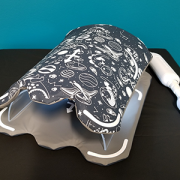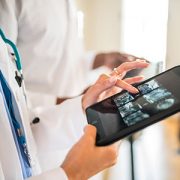Overcoming real and perceived barriers to pediatric device innovation

A working group of innovators, engineers and clinicians from Children’s National Hospital and other institutions came together to address the real and perceived barriers to the creation of pediatric devices, such as this pediatric cardiac and vascular MRI coil developed by Inkspace Imaging.
A working group of innovators, engineers and clinicians from Children’s National Hospital, Children’s Hospital of Orange County and other institutions came together to address the real and perceived barriers to pediatric device innovation through opportunities that may change the return-on-investment in this market and improve health outcomes.
The new report, published in the Journal of Translational Engineering in Health and Medicine, mentions barriers that impede the advancement of pediatric devices, including excessive limitations for testing and validation, lack of incentives, inadequate research models and inconsistent pediatric-related knowledge among companies, regulatory experts, ethic review panels and government reviewers.
To remove the real and perceived barriers fostering excessive limitations, the researchers suggest reducing the perceived risk by establishing guidelines that standardize the review process and ethical research models, incentivizing small companies to participate in pediatric device innovation.
To increase incentives, the researchers call for the development of pediatric versions of adult devices with or without enforcement of regulations, develop incentives for small, medium and large-size companies, extend patent protection and more.
Since science corroborates the device’s effectiveness and safety, tailored pediatric research models are needed to help advance pediatric device innovation. While randomized trials in well-defined cohorts are commonly used in the scientific quest, they do not reflect the clinical practice in the pediatric devices field.
“Overcoming this barrier will require greater opportunity for creativity in the design of clinical trials, including delayed entry, intent-to-treat analysis, personalized outcome measures, and post-hoc subgroup analysis,” said Terence et al. “Effective research for pediatric device innovation will require greater ability to rely on ‘real-world’ data from post-market use of the proposed device or similar devices.”
On the education side, stakeholders, such as device sponsors and researchers, must receive an improved education on pediatric devices, according to the authors. Pediatricians should also be added to the regulatory review panels and advisory boards, so decision-makers can receive the pediatric perspective and fold it into their considerations.
“The consensus outcome of this meeting is that there are multiple opportunities, and a flexible combination of new programs and regulatory changes can be created to benefit the multiple stakeholders in pediatric device development,” said Terence et al. “An essential component will be building a cadre of experts with the development, regulatory, and clinical expertise to support all innovators.”
Kolaleh Eskandanian, Ph.D., M.B.A., P.M.P., vice president and chief innovation officer at Children’s National Hospital adds that supporting and expanding pediatric innovation is a key focus of the new Children’s National Research & Innovation Campus, the first-of-its-kind focused on pediatric health care innovation, with the first phase currently open on the former Walter Reed Army Medical Center campus in Washington, D.C. With its proximity to federal research institutions and agencies, universities, academic research centers, the campus provides a rich ecosystem of public and private partners which will help bolster pediatric innovation and commercialization.
Authors from Children’s Hospital Orange County include Terence Sanger, M.D., Nadine Afari, M.S., Anthony Chang, M.D., William Feaster, M.D., Sharief Taraman, M.D., Debra Beauregard, Brent Dethlefs, Tiffani Ghere, R.D., C.S.P., Mustafa Kabeer, M.D., and George Tolomiczenko.





